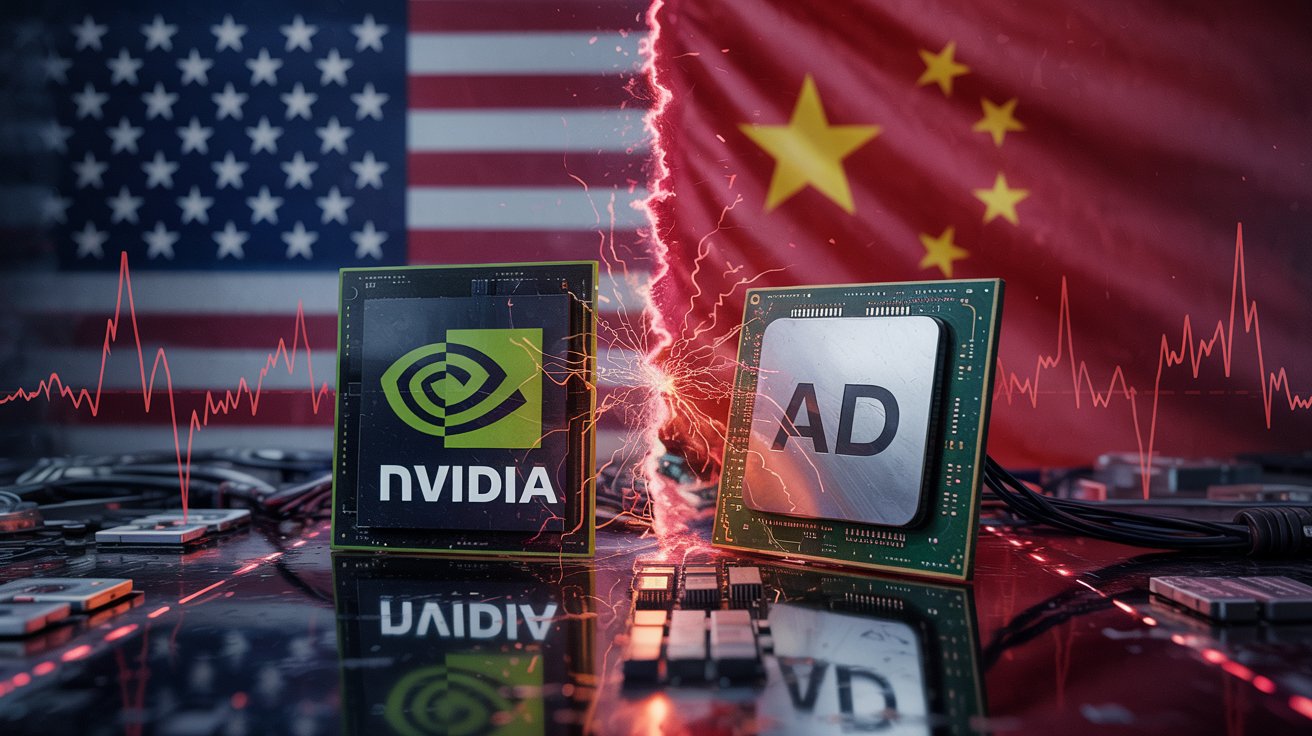AI Chip Exports to China Blocked: U.S. Move Triggers Global Market Crash — this breaking development has rattled investors worldwide as the U.S. enforces new tech restrictions that have already wiped billions off the market. The decision reshapes the future of artificial intelligence, global trade, and economic relations between the world’s two largest economies.
What Are AI Chip Export Restrictions — And Why Now?
The United States has officially imposed a ban on exporting high-performance AI chips to China, citing national security risks. These chips, particularly Nvidia’s H20 and AMD’s MI308, are critical for AI model training, military-grade systems, and quantum computing applications.
The restrictions were enacted to prevent China’s rapid advancement in technologies that could be used for surveillance or military development.
Pre-Ban vs. Post-Ban Scenario
| Feature | Before Ban | After Ban |
|---|---|---|
| AI Chip Access in China | Unrestricted purchase of Nvidia & AMD chips | Subject to U.S. export license |
| Nvidia Revenue from China | ~$5.5 billion expected in 2025 | Forecasted loss of full amount |
| AMD China Sales | ~$800 million expected | Sales halted or delayed |
| Market Impact | Stable chip sector growth | Tech stock crash globally |
What’s the Real Economic Impact?
This decision caused an immediate shock across global stock markets, with key indices experiencing sharp losses:
- Nvidia shares dropped by over 4.8%
- S&P 500 lost 2.1% in one day
- Asia’s Hang Seng fell 2.5% overnight
- Gold surged to a record $2,487/oz as investors moved toward safe assets
This move signals the U.S. is intensifying its economic and technological competition with China, and global investors are bracing for long-term consequences.
AI Chip Exports to China Blocked, U.S. AI Chip Export Ban – Key Components
U.S. AI Chip Export Ban
│
├── Reason
│ ├── National Security
│ └── Military Surveillance Risk
│
├── Targets
│ ├── Nvidia H20
│ └── AMD MI308
│
├── Impact
│ ├── $5.5B Loss - Nvidia
│ ├── $800M Loss - AMD
│ ├── Market Crash
│ └── Supply Chain Disruption
│
└── Global Reactions
├── Wall Street Drop
├── Asia Markets Down
├── Gold Prices Up
└── China Expected Retaliation
This map helps you visualize the cause-effect structure of the U.S. ban, from the policy decision to market response and geopolitical shifts.
How This Changes the U.S.–China Tech War
The U.S. has taken multiple steps over the past five years to curb China’s access to advanced technology, but this move is by far the most aggressive.
Timeline of Key Events:
| Year | Event |
|---|---|
| 2020 | Huawei blacklisted by U.S. |
| 2023 | CHIPS Act signed to boost U.S. chip production |
| 2024 | Partial export licenses implemented |
| 2025 | Full-scale AI chip ban announced by U.S. Commerce Department |
This growing divide could lead to global tech decoupling, meaning American and Chinese tech sectors could operate separately with little interdependence — a major disruption to innovation and collaboration.
What Happens Next in the Global Market?
Global market reactions show no sign of slowing. Analysts predict:
- Continued volatility in semiconductor stocks
- Supply chain bottlenecks across Asia
- China may retaliate with rare earth mineral export restrictions
- Pressure on U.S. companies relying on Chinese manufacturing
For U.S. investors, the chip war means recalibrating risk strategies, especially those focused on the tech sector.
Final Thoughts: A New Era in Global Tech Tensions
The U.S. ban on AI chip exports to China marks a turning point. It’s not just a trade restriction — it’s a declaration of technological independence and dominance. But in doing so, it ignites economic uncertainty, global market disruption, and a technological cold war that could affect industries for decades to come.
[USnewsSphere.com / apn]





